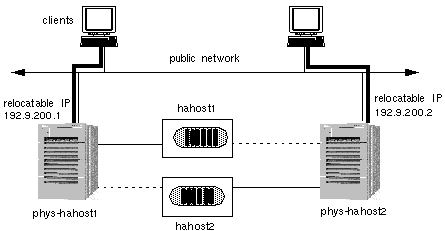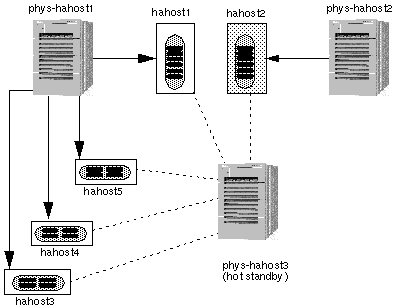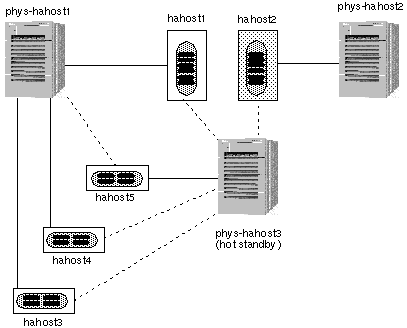1.5.10 System Failover and Switchover
If a node fails in the Sun Cluster HA configuration, the data services running on the failed node are moved automatically to a working node in the failed node's server set. The failover software moves the IP addresses of the logical host(s) from the failed host to the working node. All data services that were running on logical hosts mastered by the failed host are moved.
The system administrator can manually switch over a logical host. The difference between failover and switchover is that the former is handled automatically by the Sun Cluster software when a node fails and the latter is done manually by the system administrator. A switchover might be performed to do periodic maintenance or to upgrade software on the cluster nodes.
Figure 1-22 shows a two-node configuration in normal operation. Note that each physical host masters a logical host (solid lines). The figure shows two clients accessing separate data services located on the two logical hosts.
Figure 1-22 Symmetric Configuration Before Failover or Switchover

If phys-hahost1 fails, the logical host hahost1 will be relocated to phys-hahost2. The relocatable IP address for hahost1 will move to phys-hahost2 and data service requests will be directed to phys-hahost2. The clients accessing data on hahost1 will experience a short delay while a cluster reconfiguration occurs. The new configuration that results is shown in Figure 1-23.
Note that the client system that previously accessed logical host hahost1 on phys-hahost1 continues to access the same logical host but now on phys-hahost2. In the failover case, this is automatically accomplished by the cluster reconfiguration. As a result of the failover, phys-hahost2 now masters both logical hosts hahost1 and hahost2. The associated disksets are now accessible only through phys-hahost2.
Figure 1-23 Symmetric Configuration After Failover or Switchover

1.5.10.1 Partial Failover
The fact that one physical host can master multiple logical hosts permits partial failover of data services. Figure 1-24 shows a star configuration that includes three physical hosts and five logical hosts. In this figure, the lines connecting the physical hosts and the logical hosts indicate which physical host currently masters which logical host (and disk groups).
The four logical hosts mastered by phys-hahost1 (solid lines) can fail over individually to the hot-standby server. Note that the hot-standby server in Figure 1-24 has physical connections to all multihost disks, but currently does not master any logical hosts.
Figure 1-24 Before Partial Failover with Multiple Logical Hosts

Figure 1-25 shows the results of a partial failover where hahost5 has failed over to the hot-standby server.
During partial failover, phys-hahost1 relinquishes mastery of logical host hahost5. Then phys-hahost3, the hot-standby server, takes over mastery of this logical host.
Figure 1-25 After Partial Failover with Multiple Logical Hosts

You can control which data services fail over together by placing them on the same logical host. Refer to Chapter 2, Planning the Configuration, for a discussion of the issues associated with combining or separating data services on logical hosts.
1.5.10.2 Failover With Parallel Databases
In the parallel database environment, there is no concept of a logical host. However, there is the notion of relocatable IP addresses that can migrate between nodes in the event of a node failure. For more information about relocatable IP addresses and failover, see "1.5.8 Logical Hosts", and "1.5.10 System Failover and Switchover".
- © 2010, Oracle Corporation and/or its affiliates
